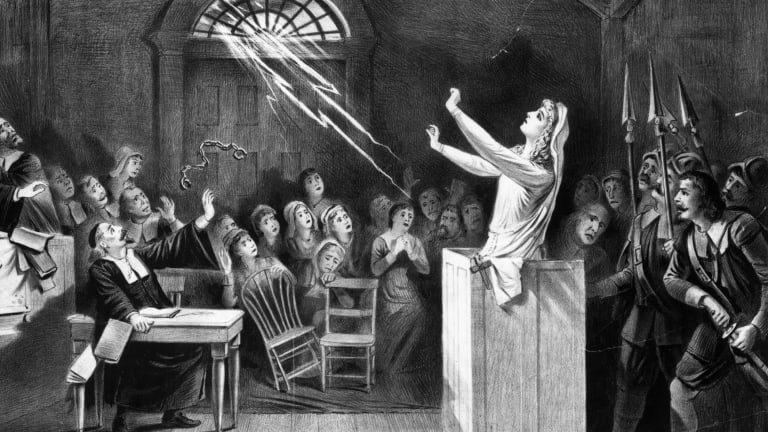The Salem witch trials of 1692 are a fascinating subject for many historians and scholars. The infamous hysteria seemed to have appeared out of nowhere and died down just as quickly. However, the question remains: What caused the Salem witch trials? Join us as we explore some of the possible reasons for one of the most notable cases of mass hysteria in American history.
Let’s take a look at the Salem Witch Trials- Brief History & Causes.
1) The background
In January 1692, 9-year-old Elizabeth (Betty) Parris and 11-year-old Abigail Williams began having violent fits which included uncontrollable screaming and muscle spasms. A local doctor diagnosed it as ‘bewitchment’. Additionally, other girls in Salem village also started displaying similar symptoms. Subsequently, the villagers blamed Parris’ Caribbean slave, Tituba. Her arrest took place in February 1692 along with two other women.
The three accused were brought to court for trial. However, despite being innocent Tituba confessed to witchcraft and alleged that other witches were acting alongside her in service of the devil against the Puritans. As a result, mass hysteria spread through the village and beyond into the rest of Massachusetts.
Like Tituba, several accused ‘witches’ confessed and named other women. As a result, the number of accused increased in number. Consequently, the local justice system could not keep up with the trials. To counter this, in May 1692, the newly appointed governor of Massachusetts William Phips established a special Court of Oyer(to hear) and Terminer(to decide) on witchcraft cases for Suffolk, Essex and Middlesex counties.
The Salem witch trials lasted from 1692 to 1693. During this period more than 200 people were accused of witchcraft; with 20 tried and executed.
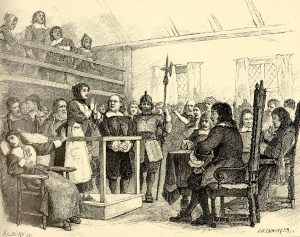
2) Many cite the cause for the Salem trials as misogyny because after all most of the accused were women. However, men stood trial for wizardry as well.
One notable example was an 80-year-old farmer Giles Corey. He refused to stand trial after being accused of ‘wizardry’. He was consequently denied a quick death and was instead gruesomely ‘pressed’ to death by stones.
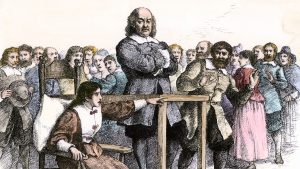
3) Bizzarly the trials did not spare even animals. According to records, at least two dogs were executed due to their involvement in witchcraft.
So the question remains, what caused the Salem villagers to act this way? Let us take a look at some of the popular theories.
4) Convulsive ergotism
The physical afflictions of the ‘bewitched’ girls baffled historians. As a result, some tried to come up with a scientific hypothesis to determine the cause of the witchcraft delusion. Subsequently, a study published by professor Linnda R. Caporael cites that the cause for the hysteria was convulsive ergotism; a condition caused by the ingestion of grain contaminated with ergot, a type of fungus. Ergot essentially contaminates rye and other grains and produces hallucinatory, LSD-like effects in the afflicted. Plus it causes the victims to suffer from headaches, delusions, vertigo, vomiting and muscle spasms.
Additionally, rye was the most prevalent grain in the Massachusetts area at the time. And factors such as the damp climate and long storage period might have contributed to an ergot infestation of the grains. Historians have also cited other such similar medical conditions as the cause of the Salem witch trials, however, they remain only as possibilities.

5) The little ice age- cold weather might have been a potential cause of the Salem witch trials
According to the theory cited in economist Emily Oster’s senior thesis at Harvard University in 2004, cold weather might have caused the Salem witch trials. The theory essentially states that the most active era of the witchcraft trials in Europe was in sync with a 400-year-long cold period known as the ‘little ice age’. Additionally, the year 1692 fell right in between an extremely cold spell that lasted from 1680 to 1780. The cold spell brought in economic deterioration and food shortages. Moreover, during that era, people believed in ‘witches’ who were known to cause physical harm and controlled the weather. Consequently, the hard weather fuelled anti-witch fervour.
In conclusion, due to the stark circumstances paired with bad weather and a bad harvest, most must have concluded it was the work of witches.
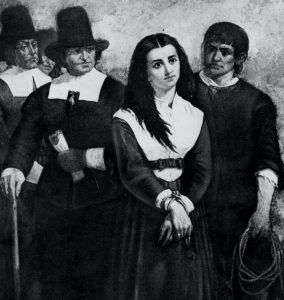
6) Boredom
Yes, you read that right! Another popular cause of the Salem witch trials is cited as boredom. During the time, Salem was a very religious place, where children were just expected to read the bible and do chores. The mass hysteria began when Betty Parris and her cousin Abigail Williams started showing symptoms of being ‘bewitched’; throwing fits and having violent muscle spasms.
However, some say they were playing a fortune-telling game. Their slave Tituba introduced it to them. As a result, it became their only leisure activity, however, they might have become consumed by superstition. Hence, their fear of the game, and the added guilt of playing it must have fuelled their violent behaviour.
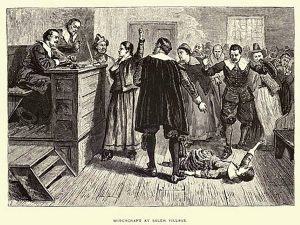
7) Could hysteria itself be the cause of the Salem witch trials?
The ‘rapid spread of conversion disorder’ a.k.a mass hysteria is said to be another cause of the Salem witch trials of 1692. Mass hysteria essentially transmits the collective illusion of threats, whether real or imaginary through a population and society as a result of rumours and fear.
Some cite this as exactly what must have happened to the two young girls. The stress of living in such a strict and religious society might have affected them and induced stress-related physical symptoms. Their fear and hysteria, added with the diagnosis of ‘bewitchment’, might have triggered the same in the rest of the population. Consequently, paving the way for the infamous witch hunts.

8) Post-Traumatic Stress Disorder(PTSD) from the Indian wars
The Indian attacks impacted most people in the Salem village in one way or another, thus creating an atmosphere of anxiety and stress; leaving most people afraid of further attacks. Additionally, some of the ‘victims’, accusing women of ‘bewitching’ were a witness of the earlier raids. So it’s been suggested that watching these attacks might have caused some to have PTSD, prompting them to make these accusations.
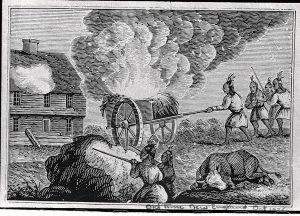
9) Ultimately, theories related to various factors have been cited, but none are the exact cause of the Salem witch trials of 1692. Hence the cause of this event remains shrouded in mystery.
10) Aftermath
In the following years after the trials, there would be individual and institutional acts of repentance by those who were involved in the trials. In January 1697, the General Court of Massachusetts announced that they would hold a day of fasting and contemplation for the tragedy of the trials; further stating that they were unlawful. Additionally, the Commonwealth of Massachusetts exonerated twenty-two of the 33 convicted individuals and even compensated their families financially.

